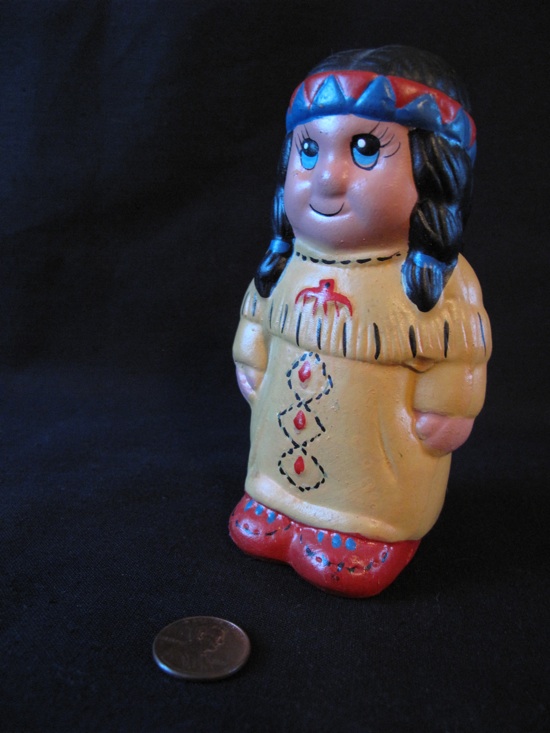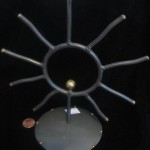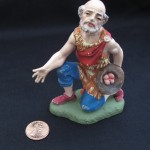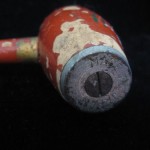[The auction for this Significant Object, with story by R.K. Scher, has ended. Original price: 99 cents. Final price: $157.50.]
Visitors never fail to ask about my squaw. It’s what I like to call her, although one of those visitors, an earnest young art critic, did try to impress upon me the incorrectness of the term. Small as she is in stature, the squaw demands attention. Hers are the only colors in my entire studio. I’m a Minimalist, after all… or as my art dealer has it, a Neo-Minimalist.
I used to enjoy telling the story of how I came by the squaw but one too many art collectors demanded her price. The story that doesn’t get told any more goes like this.
Not long after I didn’t graduate from high school, a crumbling cluster of old houses adjoining our property was slated for demolition. Exactly eleven acres of old-growth trees, two Spanish-style houses and three cottages would be razed to make way for a new suburban development. It would take all summer long and it was all I thought about.
My ideas evolved over time and became less ambitious when my parents forced me to get a job. That was when I abandoned plans to booby-trap the houses and create a homemade minefield.
Instead, every evening I took pictures of what was still there after a day of destruction and the space of what wasn’t. I made a detailed map of the whole property in pencil and erased each day what got knocked down and carted away. I spent a lot of time sitting on cut logs, stroking my old dog and taking in what happened when ancient root systems were hauled out of the ground.
One day I realized that I had to decide what to do about things that appeared instead of disappeared. The plan for the map was to end up with a blank page. I hadn’t figured on the things that get shaken out of an empty house when it’s destroyed: the objects fallen through floorboards or just left behind. There were some broken dishes, some sodden books, a bicycle wheel, a Frisbee, an empty coin purse… and the squaw.
The thing about the squaw was that she changed places. The first time I saw, and photographed, her, she was half driven into the dirt. The next photo shows her lying on some dead leaves. Then she disappeared for three days. The fourth day found her fifty yards away. This time, I plotted the location on my map, in ballpoint pen. It went on like this for weeks, an old souvenir hopscotching across a blanker and blanker landscape, followed by my ballpoint pen.
At this point in the story I usually got asked, Who was it? Did you ever find out who – or what – was moving the thing around? The answer is, No, I never tried. The day the pattern of her movements closed in on a perfect repetition is the day I picked her up and brought her home.
This is the pattern I have been drawing ever since.







magic story.
c’est tres bon! quelle imagination… Bravo R. K. Scher.
Dear Rachel, what a lovely story–magical, yes. Your imagination and the flow of the tale carry me on and on, to the marvelous end. It made me think of some artists whose work I admire, like Agnes Martin; I love the idea that there’s a pattern, I think your story is religious and optimistic, even though there was destruction too. Are both necessary?
OF course there’s much more to say, maybe we will meet in NYC if you 3 are here this winter. I hope so–
Thanks, and much love from Flora
Dear Rachel,
Beautifully woven. I really said “Oh, wow!” out loud in my tiny office when I reached the final line.
Best in all your work,
Sincerely,
Matt
with a story like that, how can you give her up, The Squaw? Committing her story to pen&paper (or cyberpaper) only adds to her value… to be rescued from rubble, sanctuaried on a strategic sunnyside studio window, and now to auctioned on eBay…what a twist!
It makes you wonder how many other stories are just floating around out there in the rubble. Not unlike the lives and stories of those who have been displaced all over the world.
Great story. I love the squaw and her commanding presence. As if you weren’t following her trail around the wreckage, but that she was leading in a path of self discovery to get you to pick her up.
Bien fait, Rachelle!